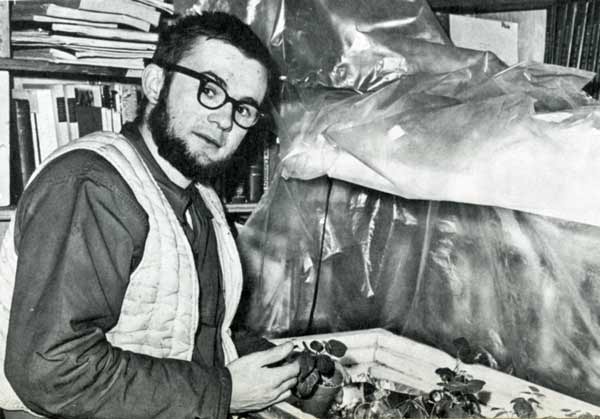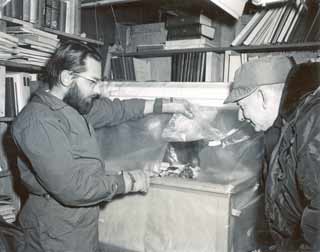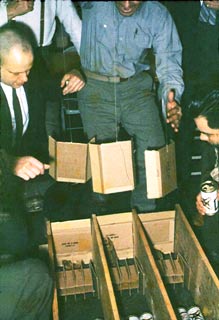 David L. Sylwester, the Arctic Institute of North America (AINA) aurora observer for the 1961 summer/winter, tends bean plants left over by a summer biology project (U. S. Navy Deep Freeze 61 cruisebook photo).
 The 1960-61 summer season brought a rather unusual science project to Pole (and McMurdo) led by Dr. Karl C. Hamner of UCLA. He was assisted by Giri Raj Singh Sirohi, the first citizen of India to visit Pole. The team studied the effects of the rotation of the Earth on the "biological clocks" of plants and animals. The team brought bean plants, 19 hamsters, 50 cockroaches, fruit flies, cockleburs, and a Neurospora (bread mold) fungus to the ice for the project... along with clock-driven rotating turntables, which were run counter to or in the same direction as the Earth's rotation. Various effects on the specimens were observed, including the leaf movements of the bean plants, the emergence of the fruit flies, the growth bands of the fungus, and the activity patterns of the hamster. At right, USARP public affairs rep Richard Litell (left) shows RADM David Tyree (commander of Deep Freeze operations) the bean and morning glory plants during an 8 February 1961 DV visit. The 1960-61 summer season brought a rather unusual science project to Pole (and McMurdo) led by Dr. Karl C. Hamner of UCLA. He was assisted by Giri Raj Singh Sirohi, the first citizen of India to visit Pole. The team studied the effects of the rotation of the Earth on the "biological clocks" of plants and animals. The team brought bean plants, 19 hamsters, 50 cockroaches, fruit flies, cockleburs, and a Neurospora (bread mold) fungus to the ice for the project... along with clock-driven rotating turntables, which were run counter to or in the same direction as the Earth's rotation. Various effects on the specimens were observed, including the leaf movements of the bean plants, the emergence of the fruit flies, the growth bands of the fungus, and the activity patterns of the hamster. At right, USARP public affairs rep Richard Litell (left) shows RADM David Tyree (commander of Deep Freeze operations) the bean and morning glory plants during an 8 February 1961 DV visit.

The results--as far as science was concerned--modifications of the Earth's rotation had no apparent effects on any of the organisms. But for the winterovers, the results were much more significant. When the study ended, the specimens were left behind. Obviously there was no interest in some of the stuff, but folks continued to tend to the bean plants during the winter (above photo--abundant leaves and little else) and the hamsters. There had been 6 hamsters, 3 males and 3 females...and there were several litters born. The first of these is a bit of history--the hamster Pandora gave birth to twins on 14 March 1961. This is the first recorded birth of any species at Pole. Unfortunately all of the young either died and/or were eaten by their parents. Some time after the winter started, the last of the males died off, leaving only the 3 females. The result of having them around--there were hamster races after the Midwinters Day banquet. An obstacle course was devised by several of the scientists for the race...hence the photos at left and below.
[As an aside note, this project was seriously considered in the Navy planning for the new station--specifically there was an animal room in the back of Biomed with a washable floor and a floor drain to allow for hosing out the animal cages. There never was such a project, and eventually the room was used for senior management berthing instead.]
|
|
I should point out that this was not the first experiment with growing things at Pole. Other than the dogs that many of the IGY station crews kept as pets, informal greenhouse experiments were common--beginning with the 1957 winter! Paul Siple wrote in his book 90° South that the first plant to survive an entire year at Pole was a potted philodendron which had been given to Paul by a neighbor in Arlington, VA. Cliff Dickey was a passionate gardener, and he helped Paul and Doc Taylor construct the hydroponic garden in a large aluminum baking pan. The pan was painted with varnish on the inside to protect the metal from the chemicals, and covered with a pasteboard lid. The plants were placed in 3 similarly varnished breadpans that were set inside the aluminum pan. In addition to the philodendron, there were sweet potatoes, watercress. radishes and clover. The watercress sprouted into leaf in 48 hours, and Paul declared the experiment a success, although molds and fungi (presumably from spores that were found to be present in the melted snow water) proved to be a problem.
Paul and Doc Taylor had consulted with a group of mycologists before bringing this project to Pole, and Paul said, "...it was perhaps the most sensational discoveries made at the South Pole."
In addition to the references mentioned above, the technical description of the science project was taken from the Bulletin of the US Antarctic Projects Officer, Vol. II No. 9, May 1961, pp. 1-2. Additional info about the hamsters as well as the color photos came from personal communications with Dr. PK Swartz, the 1960-61 OIC and physician. The photo of RADM Tyree is an official US Navy photo by OHC Frank Kazukaitis, with thanks to Bruce Raymond.
|